
Boxing is a combat sport and a martial art in which two people, usually wearing protective gloves and other protective equipment such as hand wraps and mouthguards, throw punches at each other for a predetermined amount of time in a boxing ring.

James "Buster" Douglas is an American former professional boxer who competed between 1981 and 1999. He reigned as undisputed world heavyweight champion in 1990 after knocking out Mike Tyson to win the title. He also defeated heavyweight world champions Oliver McCall, Trevor Berbick, and Greg Page.
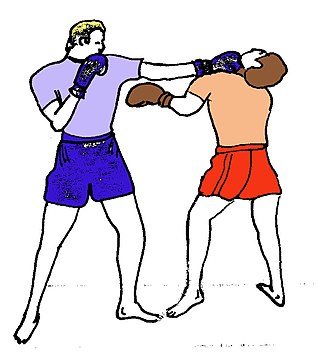
A jab is a type of punch used in martial arts. Several variations of the jab exist, but every jab shares these characteristics: while in a fighting stance, the lead fist is thrown straight ahead and the arm is fully extended from the side of the torso. This process also involves a quick turn of the torso. It is an overhand punch; at the moment of impact, the pronated fist is generally held in a horizontal orientation with the palm facing the ground.
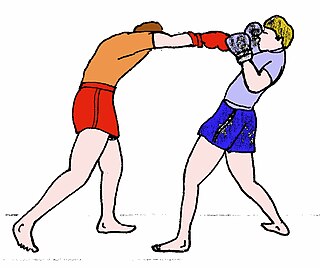
In boxing, a straight or cross are punches usually thrown with the dominant hand and are power punches like the uppercut and hook. Compubox, a computerized punch scoring system, counts the straight and cross as power punches.

A bolo punch is a punch used in martial arts. The bolo punch is not among the traditional boxing punches.

A strike is a directed physical attack with either a part of the human body or with an inanimate object intended to cause blunt trauma or penetrating trauma upon an opponent.
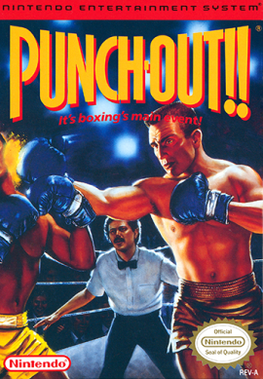
Punch-Out!!, originally titled Mike Tyson's Punch-Out!!, is a 1987 boxing video game developed and published by Nintendo for the Nintendo Entertainment System (NES). Part of the Punch-Out!! series, it is an adaptation of the arcade video games Punch-Out!! (1984) and Super Punch-Out!! (1984). Differences from the arcades include the addition of undisputed world heavyweight champion Mike Tyson as the final boss. It received critical acclaim, and is retrospectively considered one of the greatest video games of all time.
Strikes can be offensive moves in professional wrestling, that can sometimes be used to set up an opponent for a hold or for a throw. There are a wide variety of strikes in pro wrestling, and many are known by several different names. Professional wrestlers frequently give their finishers new names. Occasionally, these names become popular and are used regardless of the wrestler performing the technique.

A punching bag is a sturdy bag designed to be repeatedly punched. A punching bag is usually cylindrical and filled with various materials of suitable hardness.

Punching power is the amount of kinetic energy in a person's punches. Knockout power is a similar concept relating to the probability of any strike to the head to cause unconsciousness or a strike to the body that renders an opponent unable to continue fighting. Knockout power is related to the force delivered, the timing, the technique, precision of the strike, among other factors.

Footwork is a martial arts and combat sports term for the general usage of the legs and feet in stand-up fighting. Footwork involves keeping balance, closing or furthering the distance, controlling spatial positioning, and/or creating additional momentum for strikes.
Donovan "Razor" Ruddock is a Jamaican-born Canadian former professional boxer who competed from 1982 to 2001 and in 2015. He is known for his two fights against Mike Tyson in 1991, a fight against Lennox Lewis in 1992, and a fight with Tommy Morrison in 1995. Ruddock was also known for his exceptionally heavy punching; some of the best examples of his left hand and overall power was his knockouts of former WBA heavyweight champions James Smith in 1989, Michael Dokes in 1990, and Greg Page in 1992. His favoured weapon at the ring proved to be a highly versatile half-hook, half-uppercut left-handed punch he called "The Smash" which accounted for the majority of his knockout wins -- it also happened to be his major downside throughout his career. Being a left-handed puncher fighting out of the orthodox stance, he didn't throw a single right hand during most knockout flurries.
Peek-a-boo is a boxing style which received its common name for the defensive hand position, which are normally placed in front of the face, like in the baby's game of the same name. The technique is thought to offer extra protection to the face whilst making it easier to jab the opponent's face. The fighter holds their gloves close to their cheeks and pulls their arms tight against their torso. A major proponent of the style was trainer Cus D'Amato, who didn't use the term peek-a-boo and instead referred to it as a "tight defense." The style was criticized by some because it was believed that an efficient attack could not be launched from it.

Throughout the history of gloved boxing styles, techniques and strategies have changed to varying degrees. Ring conditions, promoter demands, teaching techniques, and the influence of successful boxers are some of the reasons styles and strategies have fluctuated.
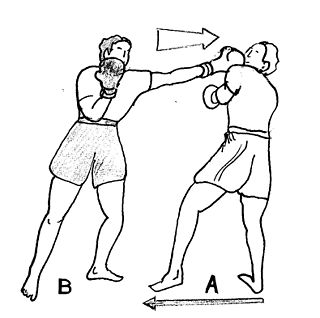
In boxing, the "one-two combo" is the name given to the combination consisting of two common punches found in boxing – a jab followed by the cross. In boxing parlance, fundamental punches are commonly assigned numbers by trainers and in this case there is the jab (#1) and the cross (#2).
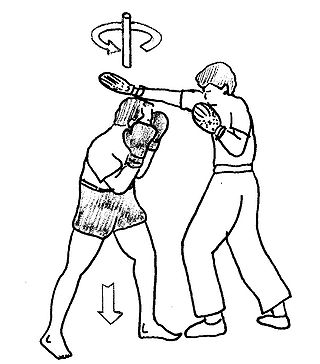
In boxing, bobbing and weaving is a defensive technique that moves the head both beneath and laterally of an incoming punch. As the opponent's punch arrives, the fighter bends the legs quickly and simultaneously shifts the body either slightly right or left. Fighters generally begin weaving to the left, as most opponents are orthodox stance, and therefore strike with a left jab first. Common mistakes made with this move include bending at the waist, bending too low, moving in the same direction as the incoming punch, and squaring up.

Bobbing is one of the basic strategies of defensive boxing, executed by slightly moving the head to either side so that the opponent's punches slip by the boxer's head. The slip is used to evade swings, jabs, and straight punches. It can not be used with hooks as they move on the side level. Using slips is valid but risky with uppercuts since the punch is usually too close when the defender can determine the exact line of the punch. To overcome the hooks problem, the defender usually incorporate slipping with ducking

The uppercut is a punch used in boxing that travels along a vertical line at the opponent's chin or solar plexus. It is, along with the cross, one of the two main punches that count in the statistics as power punches.
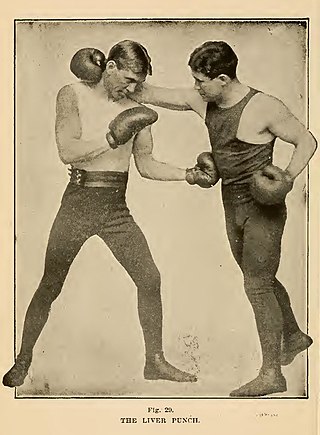
A liver shot or liver punch is a punch, kick, or knee strike to the right side of the ribcage that damages the liver. Blunt force to the liver can be excruciatingly painful, and an especially effective shot will incapacitate a person instantly. Thus, in combat sports, liver shots often result in technical knockouts (TKOs).

















